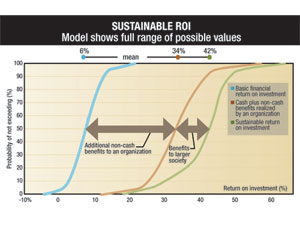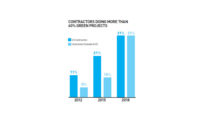A new process that measures the value of the social and environmental benefits of projects is generating buzz among academics, the private sector, public entities and government agencies. Developed by Omaha, Neb.-based engineering consultant HDR, the Sustainable Return on Investment (SROI) process allows decision-makers to evaluate a potential project’s overall sustainability benefits by assigning monetary values to environmental, social and economic impacts.
“Communities want to create sustainable solutions, but they need to be able to show taxpayers a return on investment,” says Elwin Larson, HDR executive vice president. “The missing link has been how do you show a return on green. Now communities can compare sustainable benefits on a dollars-to-dollars basis.”
Other companies and groups have worked with similar concepts, but HDR is one of the first to “aggregate things that policymakers and stakeholders have [traditionally] had to look at separately,” says Jason Hartke, vice president of national policy with the U.S. Green Building Council. “It’s another tool in the toolbox that helps build the case for sustainability,” he adds.
The process builds on the traditional concept of return on investment by putting monetary values, based on existing data from respected sources, on “things that are traditionally not monetized,” such as carbon emissions saved or the impact of improved productivity on improved indoor air quality, says David Lewis, HDR’s national director of economics and finance. “For each individual project, we try to get the best available data” from published sources as well as internal resources, says Stephane Larocque, HDR’s principal economist. The firm’s economists then use the data to develop a probability curve that shows the likely return on investment of “soft” factors such as impact on the environment, improved productivity or social benefits.
“It’s a mix of a fixed framework but applied to location and client-specific needs,” Larocque says. The model offers expected or average results, but it also provides the full range of possible values in the S-curve diagram, he says. The goal is to give project owners a tool that demonstrates a direct monetary value of building green.
Barbara Bigge, government-affairs officer with Denver Water, says she used SROI on a new $475-million, 24-million-gallon-per-day (mgd) satellite wastewater treatment plant in the planning stages last fall. “We decided that in this day and age, there was no way to do a project like this without incorporating a sustainability evaluation and sustainability concepts,” Bigge says.
HDR submitted the winning proposal. “I don’t think we went out looking for the SROI tool, but when we saw just how powerful it is in being able to evaluate different alternatives from a broad sustainability perspective,” they opted to use the process.
Bigge and her team used SROI to determine whether the significant budget dedicated to odor control at the plant was justified. “It allowed us to put a value on that and demonstrate to our senior management and our board of directors that, yes, this is a significant amount of money, but here are the benefits to society,” she says. “I don’t know how you would capture that with a traditional tool.”
Denver Water will use SROI during the upcoming design definition phase of the project, Bigge says.
Organizations ranging from Columbia and Harvard universities to the Clinton Climate Initiative (CCI) have expressed interest. HDR recently made a commitment to CCI to further refine the process, and HDR’s John Williams has taught a graduate-level class to students at Columbia. Larocque notes the process is not proprietary. “No one is doing the same thing ... but Columbia [and others] want this to become more widespread.”




Post a comment to this article
Report Abusive Comment